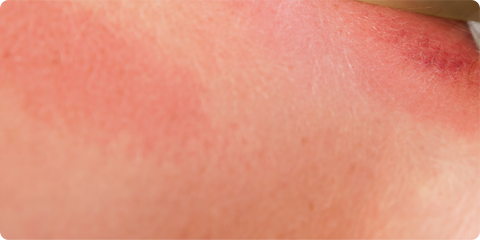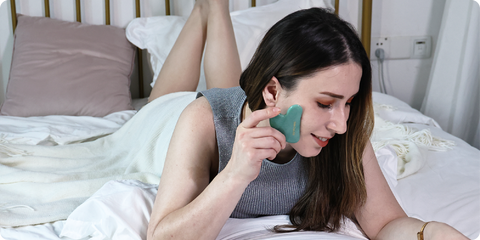Is Bruising From Gua Sha Dangerous? The Truth About Facial vs. Body Gua Sha Bruising
Introduction
Gua sha has become a major wellness and beauty trend in recent years. This ancient Chinese medicine technique involves scraping the skin to promote blood flow and healing. Traditionally done on the body, gua sha intentionally causes light bruising called "sha" in Chinese. However, recently, gua sha tools and techniques have been marketed for the face as anti-aging and skin-enhancing. This new facial gua sha diverges from the traditional technique and lacks scientific evidence. So, is the bruising sometimes caused by gua sha really dangerous? Or is it an expected side effect? In this article, we'll take an in-depth look at bruising from both traditional and facial gua sha and evaluate if it's a real concern or simply a natural response.

What is Gua Sha?
To understand the bruising, it helps to first learn what gua sha is and how it originated. Gua sha is an ancient Chinese medicine practice that involves scraping the skin with a smooth-edged tool like a spoon, coin, or jade. It is typically performed on the back, shoulders, and neck. The "gua" in gua sha refers to scraping or scratching, while "sha" translates to bruising from the technique.
Gua sha intentionally creates light bruising on the body as a way to improve overall blood circulation and health. The vigorous scraping brings blood to the surface. This process essentially "releases" stagnation and blockages in the tissues and muscles. The two main types of bruising from traditional gua sha are:
- Petechiae: Small red dots caused by minor capillary damage. This superficial bruising is the most common.
- Purple Bruising: Larger bruised areas that can look alarming but are not dangerous. This bruising indicates the breaking up of fascial adhesions.
Why Does Gua Sha Cause Bruising?
When learning gua sha, many are startled the first time those red and purple bruises appear. However, the bruising is a perfectly normal response, not damage. Scraping the skin vigorously creates injury to the capillaries right under the skin surface. Blood leaks out, and the body's clotting and healing process results in bruising.
Gua sha is thought to improve circulation by moving out stagnant blood and fluid in the muscles and connective tissues. Picture adhesions or knots being smoothed out – this can result in minor muscle and tissue trauma. Bruising occurs because the tissues are not accustomed to this increased blood flow. The more tense and blocked the muscles are, the more bruising is likely with those first gua sha treatments.

Over time, with regular practice, the appearance of bruising often decreases. This indicates the tissues and muscles are becoming healthier, with improved circulation. Once the body adjusts, increased blood flow and healing can occur without the bruising response.
Is Bruising Dangerous?
For most people, the minor bruising caused by traditional gua sha is not dangerous. The bruises are superficial, similar to the marks left from cupping therapy. However, some people are advised to avoid gua sha, where bruising may occur:
- Over areas with implants, pacemakers, or medical devices
- On recent wounds or stitches
- If taking blood thinners or having clotting issues
- If pregnant, elderly, or have medical conditions
Always consult your doctor before starting gua sha, especially if you are concerned about bruising. Other reasons to be cautious about bruising:
- Excessive pain when the scraping occurs
- Bruising seems deeper or more painful than surface-level
- Bruises last longer than a week to 10 days to resolve
Bruising alone is not necessarily a reason for concern. It can be considered a positive sign that your blood and energy flow is improving! However, use common sense and seek medical advice if anything seems abnormal.
Facial Gua Sha Considerations
In the past few years, gua sha tools and techniques have been increasingly marketed for facial massage. Jade and rose quartz stones are sold claiming to enhance skincare, sculpt the face, decrease wrinkles, and more. However, this diverges from traditional gua sha in key ways:
- Gua sha was not historically practiced on the face
- It involves much gentler pressure than body gua sha
- No scraping or bruising should occur
There is limited research showing measurable anti-aging benefits from facial gua sha massage. A gentle lymphatic drainage massage can help temporarily reduce puffiness. And the relaxation and increased blood flow give a temporary glow but no permanent wrinkle reduction.
It is imperative facial gua sha be extremely gentle. Pressing too hard can potentially damage delicate facial capillaries or skin. Use light, sliding motions instead of scraping. Discontinue use if skin becomes irritated or sore. Introduce new skincare products slowly to avoid interactions.
While gua sha bruising on the body is no major cause for concern, facial bruising indicates the technique is too harsh. Do not attempt to recreate the vigorous scraping of traditional gua sha on the delicate skin of the face and neck.
Conclusion
Gua sha is growing in popularity as a wellness and beauty practice. But its origins as an intentional bruising therapy raise questions around safety and benefits. For traditional gua sha on the body, minor bruising is common yet not dangerous for most people. It fades within a week or so. The bruises indicate a positive circulation response, not damage.
While gua sha can be enjoyed gently as a massage technique, consumers should be wary of miracle medical claims with no backing. Superficial bruising from body gua sha generally is not a major concern and fades quickly. But excessive pain or bruising on the delicate face is a red flag to stop. With common sense and moderation, gua sha can be safely incorporated into wellness routines.
Read More
- Gua Sha for Cheekbones: Sculpt Graceful Cheekbones Naturally – Rena Chris
- Gua Sha for Neck Pain: Release Tension and Recover Mobility – Rena Chris
- Relieve Stress and Pain Naturally with Gua Sha Therapy - Learn How to Use Jade Gua Sha Tool for Optimal Results – Rena Chris
- Gua Sha: Reduce Wrinkles and Maintain Youthful Appearance – Rena Chris
- Michelle Yeoh made history – Rena Chris
